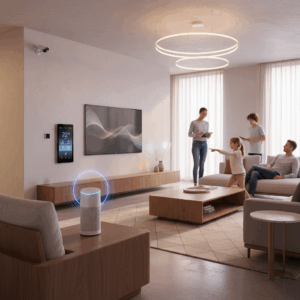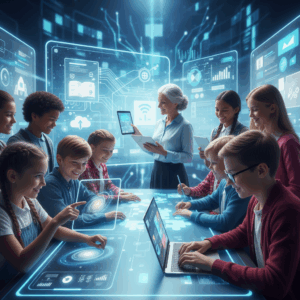Overview of Virtual Reality Evolution
Virtual Reality (VR) has evolved from simple simulators and stereoscopic images to fully immersive environments. This transformation reflects major technological advancements.
By 2025, VR has expanded beyond gaming into entertainment, professional training, and social connectivity, becoming an integral part of digital interaction and work.
Historical Development of VR Technology
VR technology began with basic simulators that created rudimentary 3D effects. Early devices focused on stereoscopic images and limited motion tracking capabilities.
Over time, innovations introduced head-mounted displays and more sophisticated sensors, enabling users to experience more immersive and interactive environments.
These developments laid the foundation for today’s advanced VR systems that support high-resolution visuals, precise motion tracking, and real-time interaction.
Current State of VR in 2025
In 2025, VR is a widespread technology used in various fields beyond gaming. Lightweight, wireless headsets with ultra-high resolution displays are common among users.
VR integrates AI-driven interactivity and enhanced motion tracking, allowing for natural user experiences across entertainment, education, and professional applications.
The VR market is growing rapidly, fueled by affordable hardware, richer content, and applications in remote collaboration, training simulations, and social platforms.
VR Innovations in Entertainment
VR innovations have revolutionized entertainment, offering deeply immersive and interactive experiences. These advances are reshaping how users engage with digital content.
The fusion of cutting-edge hardware and software has enabled richer storytelling and social connection, expanding VR’s role far beyond traditional gaming.
Immersive Gaming Experiences
Immersive gaming in VR transports players into detailed, interactive worlds, enhancing presence and engagement through realistic visuals and spatial audio.
Modern VR games feature AI-driven interactions, dynamic environments, and haptic feedback to deepen immersion, making gameplay more intuitive and compelling.
As a result, VR gaming attracts a broad audience, with increasing accessibility due to lower-cost devices and enhanced portability driving market growth.
Virtual Concerts and Social Platforms
Virtual concerts in VR create shared digital spaces where users experience live music performances together, overcoming physical and geographical limits.
Social VR platforms allow users to meet, interact, and collaborate in customizable environments, fostering new forms of connection and community building.
These virtual spaces offer immersive social experiences, blending entertainment with meaningful human interaction through avatars and real-time communication.
Advances in VR Hardware and Software
Recent hardware advances include lightweight, wireless headsets with ultra-high-resolution displays, enhanced motion tracking, and eye-tracking technology.
Software innovations leverage AI to create adaptive, responsive virtual worlds, improving user engagement and enabling more natural interactions.
Noteworthy Hardware Features
Haptic feedback and spatial audio systems boost realism, while wireless designs increase comfort and mobility, greatly elevating user experience.
VR Applications in Work and Professional Development
VR is transforming work environments by enabling remote collaboration and realistic training simulations. These tools improve engagement and practical learning outcomes.
Professional development benefits from immersive VR experiences that replicate real-world scenarios, allowing users to gain skills safely and efficiently.
Remote Collaboration and Training Simulations
VR facilitates remote collaboration by creating virtual meeting spaces where teams can interact in real-time, regardless of geographical distances.
Training simulations in VR provide safe environments to practice complex tasks, such as surgical procedures or industrial operations, without real-world risks.
These virtual sessions enhance retention and performance by offering hands-on experience with immediate feedback and scalable, repeatable training scenarios.
Integration with AI further personalizes training by adapting content to individual progress, improving effectiveness in skill acquisition and teamwork.
VR in Education and Skill Building
In education, VR creates engaging, interactive lessons that surpass traditional methods by immersing students in virtual environments tailored to their learning needs.
Skill building through VR supports diverse fields, enabling learners to practice and refine abilities in contexts ranging from technical trades to soft skills development.
VR eliminates physical and geographical barriers, granting access to quality education and training for remote and underserved populations globally.
As a result, educational institutions and corporations increasingly adopt VR to foster continuous learning and workforce preparedness in a digital age.
Future Trends and Impact of VR
The future of VR is closely linked with advances in artificial intelligence and 5G connectivity, driving more accessible and responsive immersive experiences.
These technologies help VR become a pervasive tool not only in leisure but also in professional, educational, and social spaces across industries.
Integration with AI and 5G Technologies
AI enhances VR by enabling intelligent, adaptive virtual environments that respond to user behavior in real time, creating personalized experiences.
With 5G’s ultra-low latency and high bandwidth, VR applications achieve seamless streaming and interaction, even in mobile or remote scenarios.
Combined, AI and 5G support richer content delivery and collaborative VR sessions with minimal delay, broadening the technology’s usability.
Sectoral Adoption and Transformation
Healthcare, education, real estate, and manufacturing are rapidly adopting VR to improve training, design, and remote collaboration capabilities.
VR transforms these sectors by enabling immersive simulations, realistic visualizations, and interactive workflows that enhance productivity.
This shift marks VR’s move from niche entertainment to a fundamental tool for innovation and efficiency across diverse professional fields.






